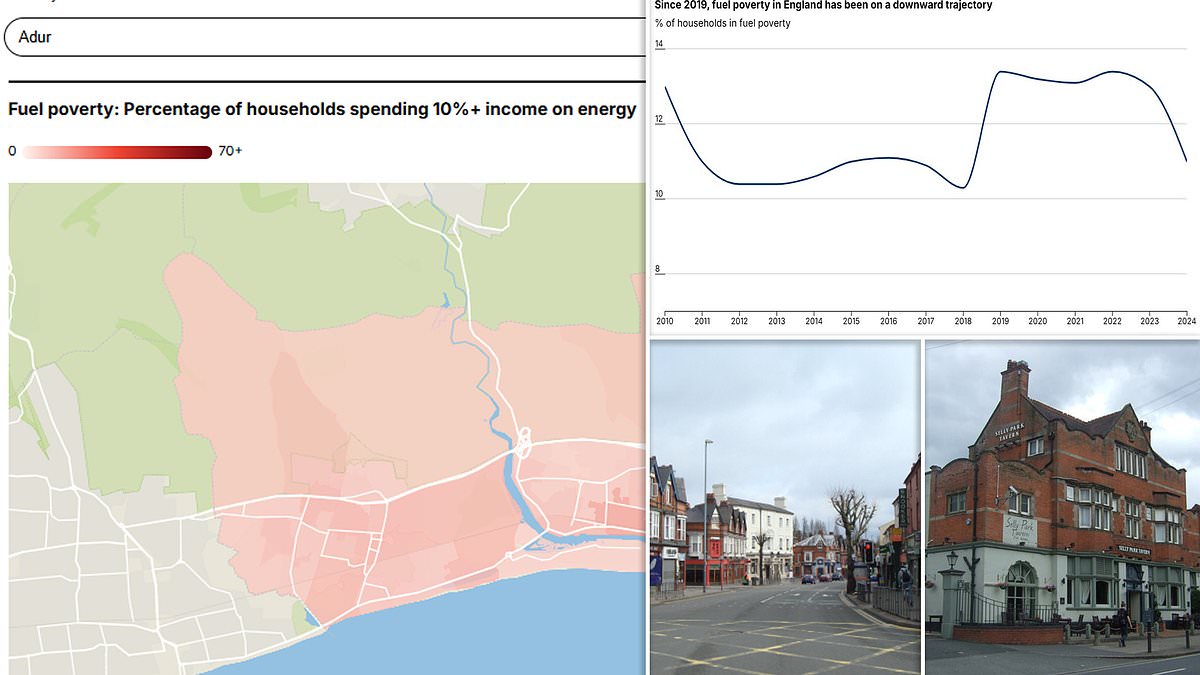The staggering extent of ‘fuel poverty’ in England is today laid bare by an interactive map.
Almost three-quarters of homes in some of the country’s most-deprived neighbourhoods fall below the threshold, can disclose.
Nationwide, one in ten housholds, or 2.73million, in 2024 were living in fuel poverty, with Birmingham named as a particular hotspot.
Officials define it as being when a home has a poor energy efficiency rating of band D or below. Their disposable income after housing and fuel costs must also fall below the poverty line – or less than around £20,700.
Fuel poverty rates have rocketed in the cost-of-living crisis, with energy firms slapping customers with inflation-busting bill hikes.
Families were hammered by yet another increase this week. Economists estimated ‘Awful April’ rises to water and energy bills would amount to £233 for homes, on average.
Experts warn that millions technically classed as being fuel poor will have no idea about their status.
Simon Francis, co-ordinator of the End Fuel Poverty Coalition action group, told : ‘This shows just how devastating the ongoing cost of living crisis is.
‘The sad reality is that, behind these figures, many people will be suffering in fuel poverty and won’t even know it.’
‘s audit, breaking down fuel poverty rates by all 36,000 neighbourhoods across England, suggest that the true rate of fuel poverty nationwide could be closer to one in eight.
A staggering 3.17million households spent more than 10 per cent of their income on energy.
The National Energy Action (NEA) charity uses that metric to define fuel poverty, instead of the Government’s wording.
Seven of the ten worst areas fell within Birmingham, our investigation showed.
England’s worst-affected zones were in the Bournbrook and Selly Park ward, where between 71.2-63.5 per cent of households sat below the fuel poverty line.
The area is popular with students of the city’s various universities.
Of all 32 lower layer super output areas (small communities consisting of around 2,000 people) where at least half of households are below the line, 14 were in Birmingham.
Nineteen of the top 20 were located within the wider West Midlands area.
The second-worst area nationally for fuel poverty was the Hanley Park, Joiner’s Square & Shelton region of Stoke-On -Trent (70.7 per cent).
Mr Francis said: ‘The Chancellor must act to reform energy markets to reduce the cost of electricity and provide help to those struggling in fuel poverty now, not continue with cuts in vital support to older and disabled people.
‘We need a government willing to invest in the long term solutions to the cost of living crisis – and the future of the country.’
Sir Keir Starmer and his energy secretary Ed Miliband have a target to improve as many Band D efficiency homes up to Band C, or minimum of 69 by 2030.
Data from March 2024 show that the average energy efficiency performance for homes in England is 68 – band D.
Adam Scorer, NEA chief executive, said: ‘These statistics show little progress was being made by the previous government to reduce the numbers in fuel poverty and therefore to meet its legal obligations.
‘This government made a commitment to do much, much better.
‘The figures show the challenge they face, but also the opportunity to turn the tide not only to make a difference for families condemned to cold, damp, unhealthy homes but to reduce pressure on health services and cut carbon emissions from leaky homes.’
Mr Scorer added that while grants to help pay bills are crucial, there must be an eye kept on longer term strategies.
He said: ‘Direct support on unaffordable energy bills is critical but so is a plan to build fuel poverty out of homes and, for the millions of renters in fuel poverty, to require landlords to do the same.
Chancellor Rachel Reeves is coming under heavy fire for what many are seeing as punitive energy cost increases.
The annual energy bill for a household on a variable tariff – as opposed to a fixed deal – using a typical amount of gas and electricity went up by 6.4 per cent or an average £111 a year to £1,849 as of the start of April 2025.
Regulator Ofgem said it has increased the cap in response to a recent surge in wholesale prices.
The limit is set every three months and limits the amount suppliers can charge for each unit of gas and electricity, but not the total bill, so if you use more, you will pay more.
It affects 22million homes in England, Wales and Scotland.
Standing charges – daily fixed fees to connect to a gas and electricity supply which vary by region – are rising again for gas but dropping for electricity, although it depends on where you live.
Though neither the Chancellor, nor Prime Minister Sir Keir Starmer will be hit by the leaps.
The two only pay a taxable benefit on running costs at the grace-and-favour apartments in Downing Street.
That is capped at 10 per cent of their ministerial salaries – meaning they contribute around £3,000 to cover all utilities and other expenses, and the sum will not go up.
This spring, the Government will produce a new fuel poverty strategy for England, publish its Warm Homes Plan and decide how to provide energy bill support next winter.
The bevy of energy price hikes adds to the potential woes of older households across England, who saw their winter fuel payment culled last September.
